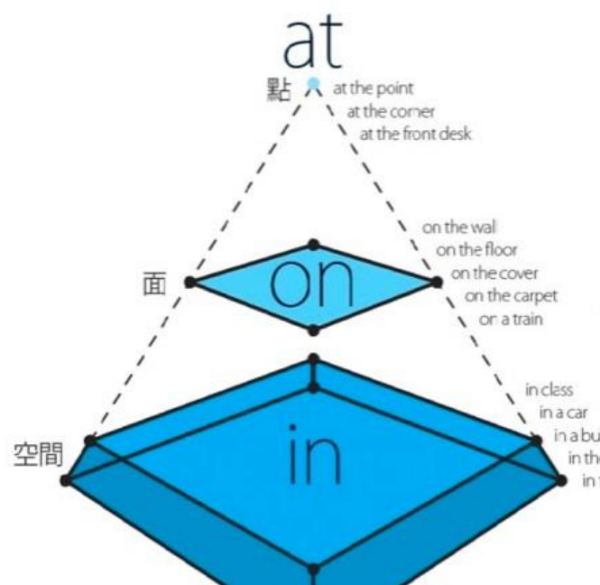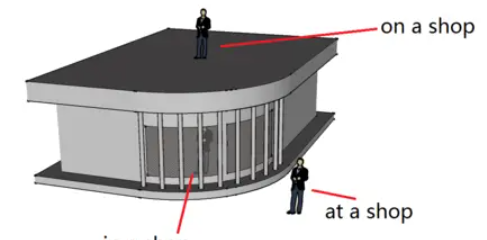本文目录
atinon在地点上分别有什么用法?
展开3全部
at,in与on的用法
1、 表示时间,注意以下用法:
① 表示时间的某一点、某一时刻或年龄等用 at:
I get up at six in the morning. 我早上六点钟起床。
He got married at the age of 25. 他 25 岁结婚。
② 泛指一般意义的上午、下午或晚上以及月或年等较长的时间,一般用 in:
We watch TV in the evening. 我们晚上看电视。
He went to Japan in 1946. 他于 1946 去了日本。
③ 若表示星期几或某一特定的日期,则用 on:
He left here on the fifth of May. 他于 5 月 5 日离开这儿。
We have English class on Monday. 我们在周一有英语课
2、 表示地点、场所、位置等,注意以下用法:
① 表示某一点位置,用 at:
We live at No 87 Beijing Road. 我们住在北京路 87 号。
The hospital is at the end of the street.这条街的尽头是医院。
与名词所有格连用表示地点,也用 at。如:
at my sister’s 在我姐姐家
at the doctor’s 在医生处(医务室)
② 表示空间或范围,用 in:
What’s in the box? 这盒子里有什么?
He lives in Paris with his wife. 他同他妻子住在巴黎。
但有时两者可换用:
The meeting was held at [in] the hotel. 会议在宾馆举行。
③ at与in的另一个区别是:at多用于指较小的地方,而in多用于指较大的地方:
in Shanghai 在上海 at the station 在车站
④ 介词 on 用于地点,主要指在某物的表面:
What’s on the table? 桌上有什么?
There’s a wallet lying on the ground. 地上有个钱包。
【注】在少数搭配中,也用介词 on:
He works on a farm. 他在农场工作。

扩展资料:
In有3种空间的概念
1、在一个比较封闭的立体空间中。
如:in a room, in a building, In a shop, in a car
2、在一个平面的地方里。
如:in a garden, in a town, in the city centre, in China。
3、在有身体接触的情况下,一般是液体里。
如:in a pool, in the sea, in a river.
On有两种
1、在某一个水平的平面、紧贴着的上面,
比如on the shelf, on a plate, on the balcony, on the floor.
2、不一定是水平的,但也是有接触面的,
比如on the wall, on the door, on the ceiling.
参考资料:百度百科-on
英语周末前用in还是on
展开1全部
on。
介词on用于星期、日期(包括该天的各部分)前,表达方式为:on
Sundays/weekdays。另外,“在周末”既可以说at
weekends,也可以说on
weekends。
需要特别注意的是:at,on都可用来表示“节假日”,但at侧重指“休假的时节”,而不是指具体的哪一天;on侧重指具体的时日,与它连用的短语中多含“Day”。
扩展资料
用at的场合
(1)表示“某一具体时刻(即几点几分时)”,须用介词at.例如:at
six
(2)用在特定的时候(时节、时机)时,须用介词at.例如:They
were
happy
at
that
time.他们那时很幸福。
(3)表示“在中午、在夜晚、在周末”时,须用介词at.例如:What
do
you
often
do
at
noon?你中午经常做些什么?
(4)表示“在……岁”时,须用介词at.例如:At
the
age
of
nine
,the
boy
could
swim
well.在九岁的时候,这孩子就游泳游得很好了。
参考资料来源:百度百科-介词
(英语介词)
参考资料来源:百度百科-on
英语中月具体时间前面加on还是is
展开3全部
一般表示某天的都是用on。
大于一天的,用in跟week搭配,一般说,in this week, on the weekend。
1、 介词on用在时间上,表示某一具体的时间前面(常表达某一天),
如:on Sunday morning ,on july ,25.
2、 介词in用在时间上,表示在某一特定时间里,或者某段时间之后,
如:in the morning,in a week.
3、介词at用在在时间上,是用某一点时间前面,
如:at six o'clock.
一个很好记的口诀:
时间介词三兄弟, in on at分清记:
年月周前要用in, 日子前面却不用;
遇到几号要用on, 上午下午又是in;
要说某日上下午, 用on换in才能行;
子夜黄昏用at, 黎明用它也不错;
at用于时分前, 兄仨各有习惯配;
灵活运用是关键, 不得生搬和硬套。
时间介词的用法
一、选用介词at的场合
1.用于钟点前。如:at ten o’clock, at a quarter to six
2.用于时刻前。如:at noon/night/midnight(半夜), at sunrise(日出时), at dusk(黄昏), at dawn/daybreak (黎明)
We will leave at daybreak.我们将在黎明时动身。
3.用于表示进餐时间。如:at breakfast/lunch/supper(在早餐时/午餐时/晚餐时)
He drinks tea at breakfast.他在早餐时饮茶。
4.用于表示年龄时。如:at 14 (=at the age of 14在14岁)
He left home at the age of 16.他十六岁离开了家。
5.用于一些固定短语或习惯搭配中。如:at Christmas, at New Year, at Thanksgiving(感恩节), at the Spring Festival, at midsummer(仲夏), at the beginning/end of last month, at the moment/ at that time, at this time of day, at a bad time of year, at first(起初), at last(终于)
二、选用介词on的场合
1.用于星期、日期(包括该天的各部分)前。如:on Sundays/weekdays, on Monday morning / afternoon / evening
I'm flying home on Sunday afternoon.我星期四下午乘飞机回家。
【温馨提示】“在周末”既可以说at weekends,也可以说on weekends。如:
I often go fishing on/ at weekends.我经常在周末去钓鱼。
2.用于morning/afternoon/evening/night/day前,此时这类名词前多有修饰语或带有of等引起的后置修饰语,指具体的或不具体的某一日。如:on a cold afternoon, on the night of October 1, 1997, on the first day, on his birthday, on Friday afternoon, on the eve of victory(胜利前夕)
The story happed on the night of October 25,1980.故事发生在1980年10月25日深夜。
3.用于公共节假日前。如:on Teachers’ Day,on Christmas Day/Eve,on National Day
【温馨提示】at,on都可用来表示“节假日”,但at侧重指“休假的时节”,而不是指具体的哪一天;on侧重指具体的时日,与它连用的短语中多含“Day”。试比较:
at New Year(在新年期间) at Christmas (在圣诞节期间)
on New Year’s Day(在元旦那天) on Christmas Day (在圣诞节)
三、选用介词in的场合
1.用于泛指一天的上午、下午、傍晚等。如:in the morning/afternoon/evening/night
2.用于某个较长的时间,像世纪、朝代、年、月、季节等。如:in March, in spring, in 1997, in the twenty-first century(在二十一世纪), in one’s fifties(在某人50多岁时)
3.用于表示“从现在起,多久以后或多长时间内”的短语之前。如:
She’ll see me again in a week’s time.一周后她再来看我。
I can draw a beautiful horse in five minutes.我可以在五分钟内画好一匹好看的马。
There are seven days in a week.一周有七天。
四、省略介词的情况
1.next,last,this,that与时间名词连用作状语时,该短语前常省略介词。如:
We’re going to work on a farm next Sunday.下个星期天,我们要去农场劳动。
They visited the Great Wall last year.去年他们参观了长城。
2.在today, tomorrow, yesterday, the day before yesterday, the day after tomorrow, tomorrow night等之前不用介词。如:
Are you free tomorrow night? 明晚你有空吗?
Where did you go the day before yesterday? 前天你去哪儿了?
地点前的介词
展开3全部
1、表示某一点位置,用at。如:
The hospital is at the end of the street.医院在这条街的尽头。
与名词所有格连用表示地点,也用at。如:
at my sister’s在我姐姐家
at the doctor’s在医务室
2、表示空间或范围,用in。如:
What’s in the box?这盒子里有什么?
He lives in Paris with his wife.他同他妻子住在巴黎。
3、介词on用于地点,主要指在某物的表面。如:
What’s on the table?桌上有什么?
There’s a wallet lying on the ground.地上有个钱包。

词义辨析
in, for
for和in都可表示时间。
1、for表示一整段时间,其动作或状态由这段时间的开始持续到这段时间的终了,因此for本身就有“持续”的含意;而in只是划定一个时间界限,而其动作或状态只局限在这个范围之内,但不一定贯穿始终。
2、表示将来的一个时期,在肯定句中用in;但在否定句中只能用for。
以上就是关于介词on用于什么前 ,atinon在地点上分别有什么用法?的全部内容,以及介词on用于什么前 的相关内容,希望能够帮到您。
